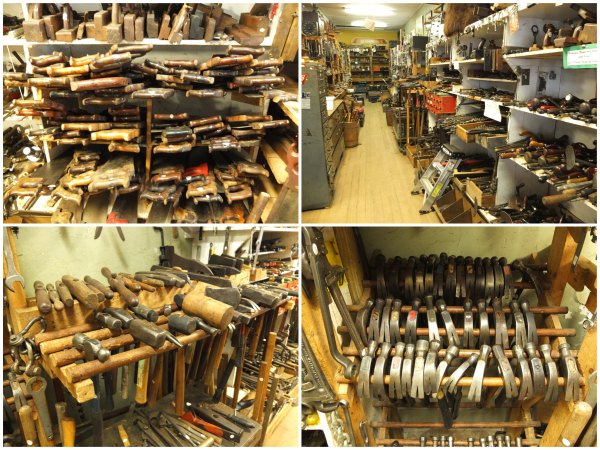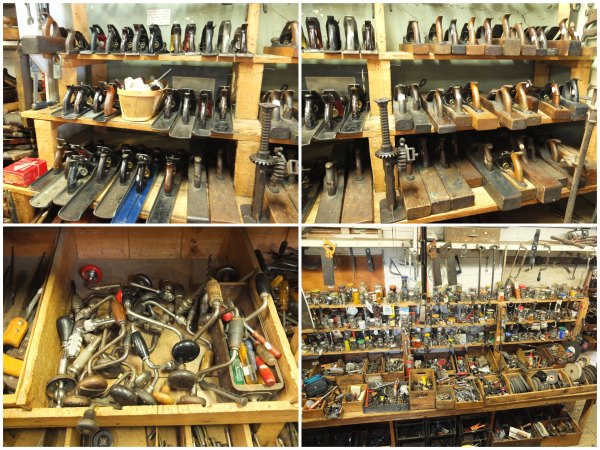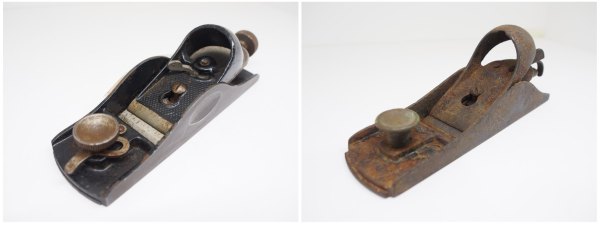I recently acquired an Ohio Tool Company No.9½ from Jim Bode Tools. Block planes from Ohio Tool are not that easy to come by, and while it seems like the designation 9½ would stigmatize it, it has some rather interesting features which set it apart from the Stanley 9½ and its kin. As the patents ran out on the Stanley planes, Ohio Tools began manufacturing several of their models. The plane has a maroon paint finish on both the body and the lever cap. There is rumour that these maroon planes emanated from the ‘Thistle’ brand of the Auburn Tool Co., which merged with Ohio Tool Co. in 1893. The trademark on the planes blade is marked “Ohio Tool Co.”, Auburn N.Y., so it is likely the plane was manufactured there under the auspices of the Ohio Tool Co.

Fig 1: The Ohio 9½
One of the most identifiable features is the swivelling lateral blade adjustment mechanism. I first saw this on a Keen Kutter KK60, which makes sense, as Ohio Tools manufactured planes for The Simmons Hardware Company. Other Ohio planes, including the No.220 sported the swivelling mechanism in their early renditions. This is an early version of the No.9½, circa 1901 – later versions from a 1910 catalog moved to the more traditional Stanley type “curved lever” lateral blade adjustment mechanism.

Fig 2: All the parts
The mechanism is quite unique amongst block planes. It made its appearance in a patent received in 1901 (No.680,055) – although employing a lever with a flat end instead of the rounded one found in this plane. Fig.3 shows the plan and profile of the mechanism from the patent. Depth-adjustment of the blade is achieved by means of a rack-and-pinion mechanism. The rack is attached to the bottom of the blade (Fig.3 – b), and the pinion section which engages it is attached to the lever (Fig.3 – d). Raising the lever lowers the blades, whilst depressing the lever raises the blade. Lateral adjustment is by means of a carriage (Fig.3 – g) which pivots around a central point (Fig.3 – h) upon a support structure (Fig.3 – m). The same lever used for depth adjustment (which is attached to the carriage) can be moved from side to side to achieve lateral adjustment.

Fig 3: Extracts from the patent showing both depth and lateral adjustment mechanisms.
Basically, in operation lengthwise adjustment of the blade is achieved by moving the lever vertically, while moving the lever crosswise moves the carriage upon its pivot and lateral adjustment is effected. At the same time a second patent (No.680,056) was also received for a similar mechanism, however the rack-and-pinion style depth adjustment mechanism had been replaced with a more commonly seen slide actuated by a screw. By the time this No.9½ had gone into production, the rack had been integrated into the blade as a series of rectangular holes, the number of teeth in the pinion had been reduced to from 3 to 2, and the lever had been modified to an “acorn” finial type. The first two of these modifications likely were driven by cost, and a simplification of the manufacturing process. The modification of the end of the lever may have been occasioned by the need to move laterally, something the flat lever in the original patent could achieve – but not in a comfortable manner.

Fig 4: Blade adjustment mechanisms
The other two interesting features are the simple lever for adjusting the size of the mouth, and the circular “handi” grip on the sides of the plane.

Fig 5: Other fun features
By 1910, ten years before the demise of Ohio Tools, the 0103, 0120, 0140 still sported the pivoting lateral adjustment using a rack-and-pinion. It appears the 060, 060½, 065, and 065½ all used pivoting adjustment, however using the “sled” and adjustment screw.
SPECS
Manufactured: circa 1901-1905?
Patent No.: 680,055 (Aug. 6, 1901)
Length: 6″, catalog, actual 6¼”
Width: 1-7/8″
Blade: 1-5/8″
Construction: cast
Finish: paint (maroon)
Trimmings: paint (maroon)
Adjustable mouth: Yes
Depth adjustment: Yes (rack-and-pinion + lever)
Lateral adjustment: Yes (pivoting carriage)
Markings: 09½ on heel of the body

Fig 6: No.9½ in profile.
NB: Apart from the Catalog No.23 of 1910, there is very little written about Ohio Tools in the open literature.
The Antique Trader Tools Price Guide (2nd ed.) of 2007 cites the price of a No.9½ in fine condition with 100% japanning as US$303. But with the market what it is today, who knows what the validity of these prices really is.













